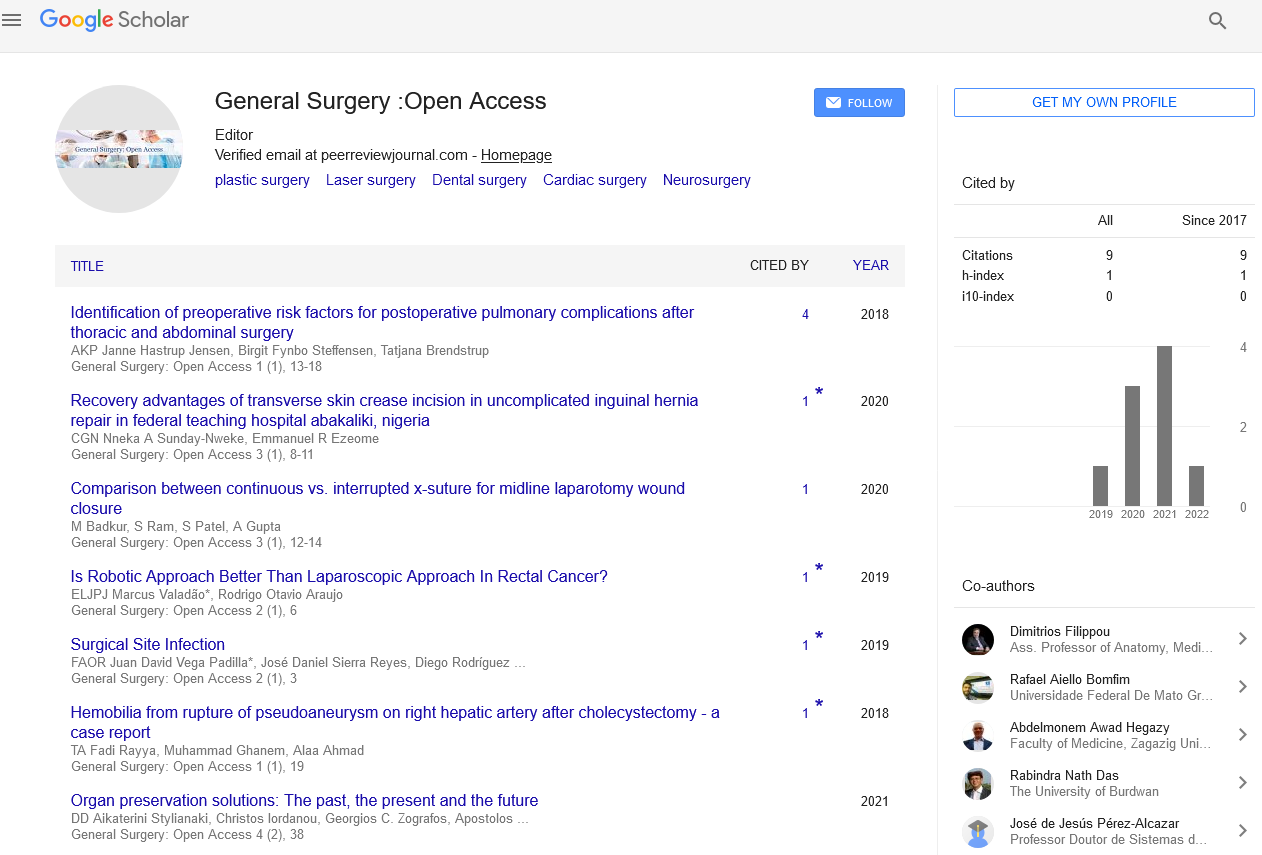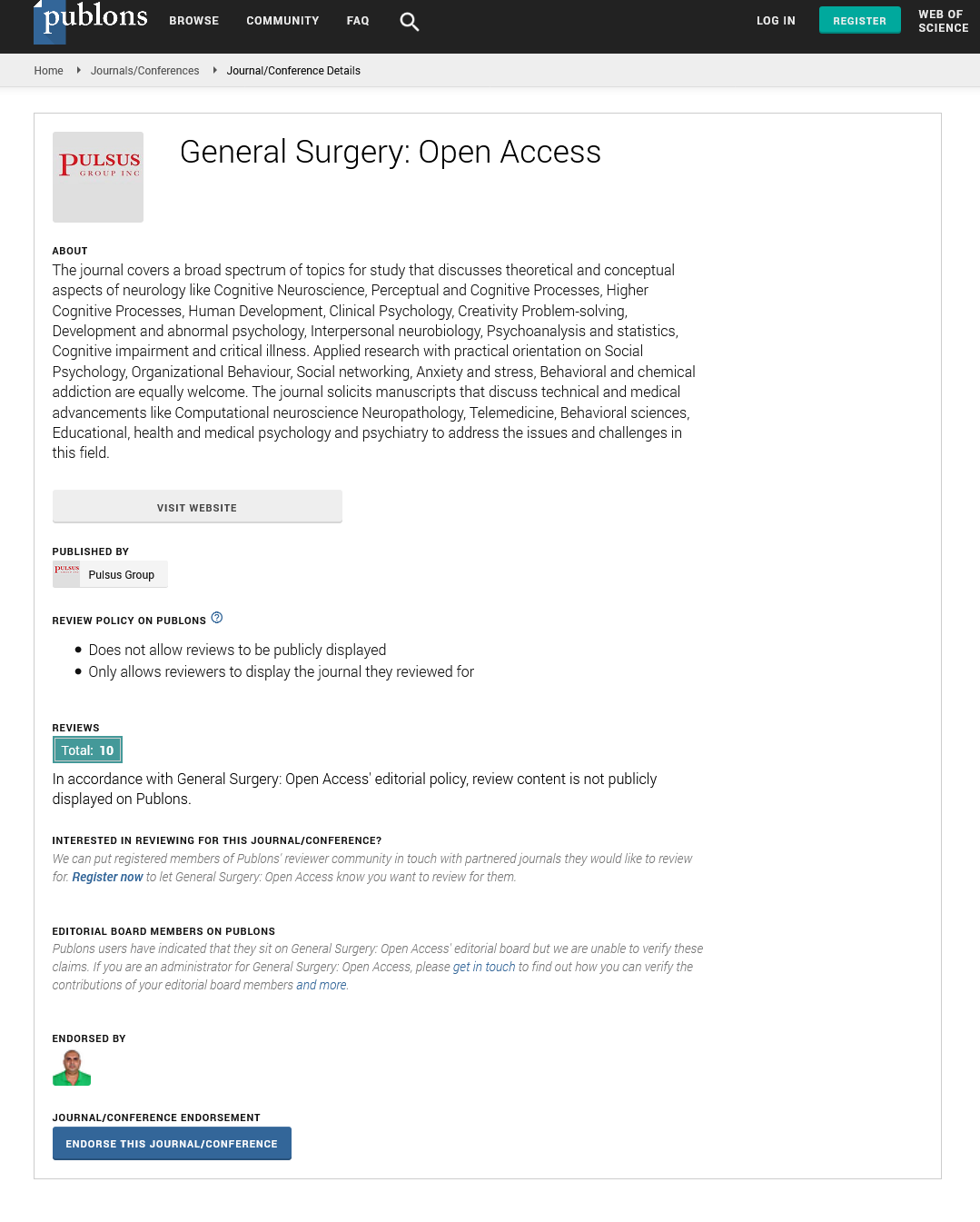Complications of thyroid surgery
Received: 05-May-2021 Accepted Date: May 19, 2021; Published: 26-May-2021, DOI: 10.37532/pulgsoa.2021.4(3).13
Citation: Hoy Q. Complications of thyroid surgery. Gen surg: Open Access. 2021;4(3):13.
This open-access article is distributed under the terms of the Creative Commons Attribution Non-Commercial License (CC BY-NC) (http://creativecommons.org/licenses/by-nc/4.0/), which permits reuse, distribution and reproduction of the article, provided that the original work is properly cited and the reuse is restricted to noncommercial purposes. For commercial reuse, contact reprints@pulsus.com
Description
The normal blood misfortune for thyroid tasks is generally little and the possibility of requiring a blood bonding is amazingly uncommon. In any case, seeping in the neck is possibly perilous in light of the fact that as the blood pools, it can push on the windpipe or windpipe causing trouble relaxing. Patients are noticed for the time being. On the off chance that there is no indication of draining and the patient feels good, they will return home the following morning. Once at home, patients should look for signs, for example, trouble breathing, a high noisy voice, growing in the neck that proceeds to broaden, and an inclination that something awful is occurring. In the event that any of these side effects occur, the patient should call 911 first and afterward their specialist.
There are two arrangements of nerves close to the thyroid organ that assistance control the vocal strings. These are the intermittent laryngeal nerve and the outside part of the unrivaled laryngeal nerve. Harm to an intermittent laryngeal nerve can make you lose your voice or become dry. Transitory roughness, voice tiring, and shortcoming can happen when at least one of the nerves are aggravated during the activity or on account of irritation that happens after the medical procedure. This generally improves inside half a month, however can require as long as a half year to determine. Indeed, even in the uncommon possibility of having a forever dry voice, there are things that should be possible to improve voice quality. An otolaryngologist or Ear, Nose, and Throat expert can be useful in deciding the particular issue and can perform various techniques to help improve voice quality.
Chronic difficulties incorporate hypothyroidism (which is the normal consequence of most thyroid medical procedure) and hypoparathyroidism. In the possession of an accomplished, high-volume specialist, the occurrence of intense inconveniences and of lasting hypoparathyroidism ought to be under 1%.
Clinical highlights: Vocal rope movement anomalies,Hacking, dyspnea and dryness after thyroid medical procedure are on the whole indications of vocal string movement anomalies. Patients with dyspnea and respiratory misery ought to be alluded promptly for direct laryngoscopy. Transient repetitive laryngeal nerve paresis, either one-sided or reciprocal, was seen in around 2.5% of patients in a single arrangement, while perpetual nerve injury happened in 1%. Reciprocal nerve injury is generally evident following extubation with stridor and respiratory pain.
Hematoma: A cervical hematoma is typically an enormous, firm stable expanding. Hematomas have been accounted for in up to 1.2% of thyroid tasks.
Hypocalcemia: Harm to the parathyroid organs during medical procedure creating gentle hypocalcemia is moderately normal, with a detailed occurrence of up to 49%. Serious hypocalcemia and lasting hypoparathyroidism is significantly less incessant. Hypocalcemia is exacerbated by coinciding nutrient D inadequacy. Preoperative assessment ought to incorporate estimation of 25-hydroxyvitamin D (25OHD) levels and substitution if conceivable before medical procedure. Manifestations range from gentle deadness and shivering to muscle jerking and squeezing and, seldom, forthcoming tetany and lockjaw. Electrocardiogram (ECG) changes can be seen with abbreviated Q-T stretches with the potential for arrhythmias.
Chyle fistulae: Answered in up to 8.3% of thyroid medical procedures when a parallel neck analyzation has been performed and are brought about by wounds to the thoracic pipe. Pieces of information to identification are swelling in the supraclavicular fossa and induration or erythema of the skin. A smooth release affirms the conclusion.
Tracheal injury: Tracheal rot is uncommon and might be seen by exuberant utilization of the electrocautery around the windpipe. Tracheomalacia can be found in the setting of huge, long-standing compressive goiters. Tracheal disturbance prompts an air spill with subcutaneous emphysema, which is possibly dangerous.
Hypothyroidism: While not an intense inconvenience of thyroid medical procedure, it is the normal outcome after an aggregate or close absolute thyroidectomy and habitually happens after less complete medical procedures. Since the half-existence of thyroxine, the key secretory result of the thyroid organ, is 7 days, indicative hypothyroidism would not present during the quick postoperative period. On the off chance that thyroid chemical substitution isn't begun postoperatively, run of the mill indications of hypothyroidism would be normal inside about a month in patients that went through an aggregate or close complete thyroidectomy.
For those patients that go through a subtotal thyroidectomy or a lobectomy, the leftover thyroid tissue may work adequately to meet the body's necessities.Hypocalcemia (low blood calcium levels) may happen after thyroid and parathyroid medical procedure on the grounds that the parathyroid organs may not capacity ordinarily just after medical procedure and brief hypocalcemia/hypoparathyroidism is normal. The parathyroid organs are four little, sensitive organs that action about the size of a grain of rice. They are situated close, or connected to, the thyroid organ and control the blood calcium levels. Every thyroid flap has two parathyroid organs. After thyroid medical procedure and before you are released home your blood calcium will be checked. You will likewise be sent home with directions to take supplemental calcium for the main little while weeks after thyroid medical procedure. Hypocalcemia can cause side effects like deadness and shivering (particularly around the lips and in the hands and feet) just as muscle cramps. At your first post-employable visit, your blood calcium level will be checked and you might be weaned off the supplemental calcium endorsed after your medical procedure. Just one half working parathyroid organ is required for calcium control. On the off chance that every one of the four parathyroid organs were harmed or eliminated during a medical procedure, the blood calcium levels can become lower than typical.






